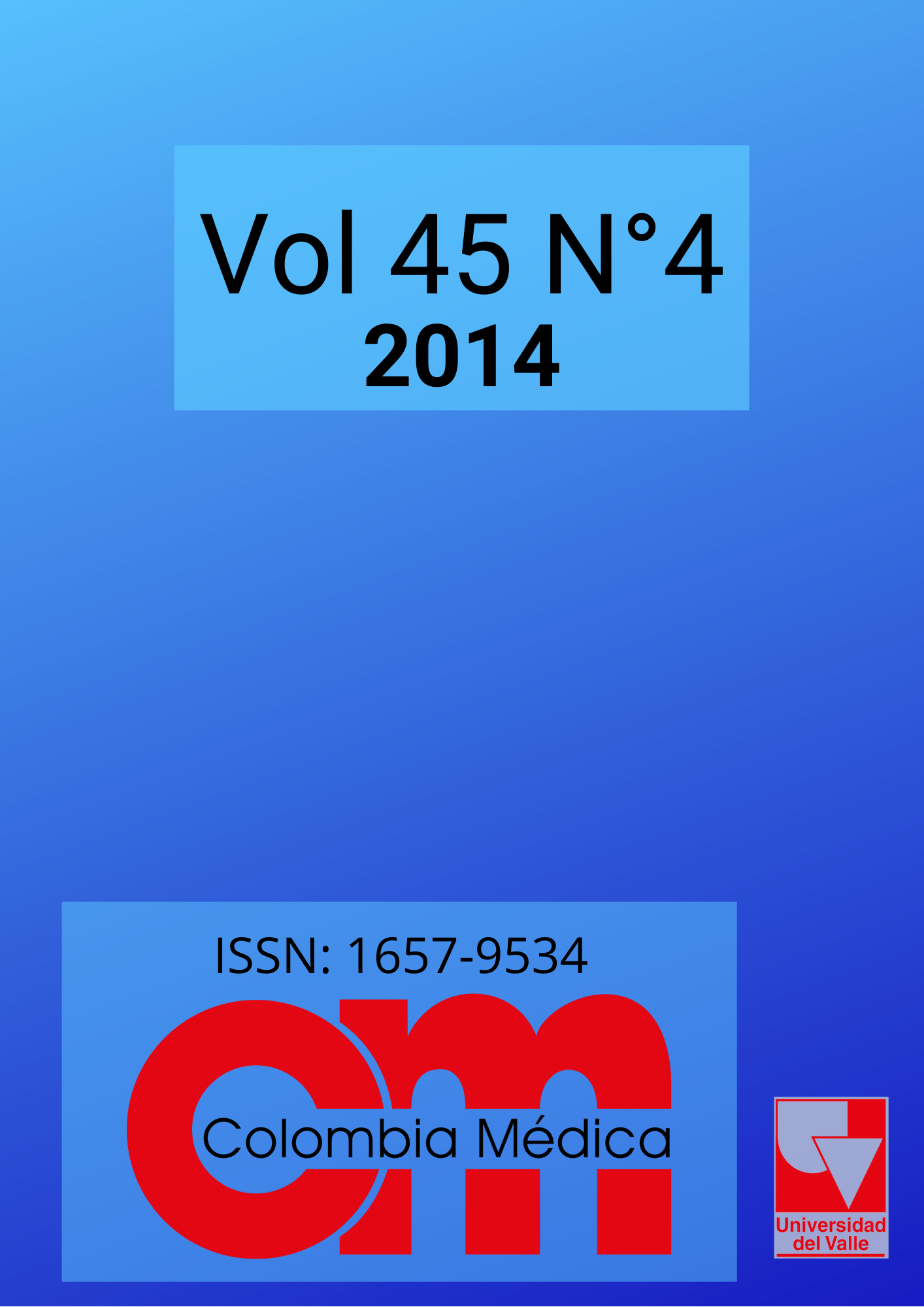Intra- and interobserver agreement on the Oestern and Tscherne classification of soft tissue injury in periarticular lower-limb closed fractures
Keywords:
Soft tissue injuries, classification, tibial fractures, ReliabilityMain Article Content
Background: The soft tissues injury in periarticular fractures of the lower extremities determines the proper time to perform bone fixation.
Objetive: The aim of this study was to determine the intra and interobserver agreement in the Tscherne classification.
Methods: This is a descriptive, prospective study for patients admitted to the Pablo Tobón Uribe Hospital (PTUH) with tibial plateau or tibial pilon fractures. We performed a standardize evaluation using video photography at the time of admission and 24, 48, and 72 h after admission. Fifteen five reviewers who had various levels of training produced a total of 1,200 observations. The intra- and interobserver agreement was assessed using a weighted kappa for multiple raters and more than two categories.
Results: Twenty patients were admitted with tibial plateau and tibial pilon fractures. The intraobserver agreement for all 15 raters was kappa 0.81 (95% CI 0.79-0.83), and the interobserver agreement for all 15 raters was kappa 0.65 (95% CI 0.55-0.73). The interobserver agreement at 24 h was kappa 0.67 (95% CI 0.46-0.86).
Conclusions:Classifying the severity of soft tissue injury is critical in planning the surgical management of fractures of the lower extremities. Based on our results, we can reasonably argue that the Tscherne classification produced an adequate level of agreement and could be used to standardize and to guide the treatment, and to conduct research studies.
Level of Evidence: Level IV, Case Series
Dirschl DCL. Classification of fractures. In: Rockwood CA, Green DP, Bucholz RW, eds. Rockwood and Green's fractures in adults. 7th ed. Philadelphia, PA: Wolters Kluwer Health/Lippincott Williams & Wilkins; 2010. pp. 39–52.
Volgas D. Preoperative assessment and classification of soft-tissue injuries. In: Volgas DA, Harder Y, eds. Manual of soft tissue management in orthopaedic trauma. Stuttgard: Thieme Verlag; 2011. pp. 54–77. DOI: https://doi.org/10.1055/b-002-85481
Sirkin M, Sanders R, DiPasquale T, Herscovici DJr A staged protocol for soft tissue management in the treatment of complex pilon fractures. J Orthop Trauma. 2004;18(8) Suppl:S32–8. DOI: https://doi.org/10.1097/00005131-200409001-00005
Egol KA, Tejwani NC, Capla EL, Wolinsky PL, Koval KJ. Staged management of high-energy proximal tibia fractures (OTA types 41): the results of a prospective, standardized protocol. J Orthop Trauma. 2005;19(7):448–55. DOI: https://doi.org/10.1097/01.bot.0000171881.11205.80
Thordarson DB. Complications after treatment of tibial pilon fractures: prevention and management strategies. J Am Acad Orthop Surg. 2000;8(4):253–65. DOI: https://doi.org/10.5435/00124635-200007000-00006
Tull F, Borrelli JJr Soft-tissue injury associated with closed fractures: evaluation and management. J Am Acad Orthop Surg. 2003;11(6):431–8. DOI: https://doi.org/10.5435/00124635-200311000-00007
Südkamp NP. Soft-tissue injury: In: Rüedi PT, Buckley RE, Moran GC. AO Principles of Fracture Management. 2 ed. Stuttgard: Thieme Verlag; 2007. pp. 86–113.
Oestern HJ, Tscherne H. Physiopathology and classification of soft tissue lesion. Hefte Unfallheilkd. 1983;162:1–10.
Oestern HJ, Tscherne H. Pathophysiology and classification of soft tissue damage in fractures. Orthopade. 1983;12(1):2–8. DOI: https://doi.org/10.1007/978-3-642-69499-8_1
Tscherne H, Oestern HJ. A new classification of soft-tissue damage in open and closed fractures (author's transl) Unfallheilkunde. 1982;85(3):111–5.
Sirkin SM, Liporace M. Chapter 14: Fractures with soft tissue injuries. In: Browner BD, Levine MA, Jupiter JB, Trafton GP, Kretter C. Skeletal Trauma: Basic Science, Management and Reconstruction. 4 ed. Philadelphia: Saunders Elsevier; 2009. pp. 367–96. DOI: https://doi.org/10.1016/B978-1-4160-2220-6.10014-3
Kottner J, Audige L, Brorson S, Donner A, Gajewski BJ, Hrobjartsson A, et al. Guidelines for reporting reliability and agreement studies (GRRAS) were proposed. J Clin Epidemiol. 2011;64(1):96–106. DOI: https://doi.org/10.1016/j.jclinepi.2010.03.002
Audige L, Bhandari M, Kellam J. How reliable are reliability studies of fracture classifications? A systematic review of their methodologies. Acta Orthop Scand. 2004;75(2):184–94. DOI: https://doi.org/10.1080/00016470412331294445
Fleiss JL, Levin BA, Paik MC. Statistical methods for rates and proportions. 3. Hoboken, NJ: J Wiley; 2003. DOI: https://doi.org/10.1002/0471445428
Landis JR, Koch GG. The measurement of observer agreement for categorical data. Biometrics. 1977;33(1):159–74. DOI: https://doi.org/10.2307/2529310
Cicchetti DV. Testing the normal approximation and minimal sample size requirements of weighted Kappa when the number of categories is large. Appl Psychol Measur. 1981;5(1):101–4. DOI: https://doi.org/10.1177/014662168100500114
Gwet KL. AgreeStat 2011. Accessed:: 1 November 2013. Available from: http://advancedanalyticsllc.com/irrhbk/agreestat.html.
Epidat [1 November 2013];V4.0 2012. a Available from: http://www.sergas.es/MostrarContidos_N3_T01.aspx?IdPaxina=62713.
Hoiness P, Engebretsen L, Stromsoe K. Soft tissue problems in ankle fractures treated surgically. A prospective study of 154 consecutive closed ankle fractures. Injury. 2003;34(12):928–31. DOI: https://doi.org/10.1016/S0020-1383(02)00309-1
Gaston P, Will E, Elton RA, McQueen MM, Court-Brown CM. Fractures of the tibia. Can their outcome be predicted? J Bone Joint Surg Br. 1999;81(1):71–6. DOI: https://doi.org/10.1302/0301-620X.81B1.0810071
Brumback RJ, Jones AL. Interobserver agreement in the classification of open fractures of the tibia. The results of a survey of two hundred and forty-five orthopaedic surgeons. J Bone Joint Surg Am. 1994;76(8):1162–6. DOI: https://doi.org/10.2106/00004623-199408000-00006
Koo H, Leveridge M, Thompson C, Zdero R, Bhandari M, Kreder HJ, et al. Interobserver reliability of the young-burgess and tile classification systems for fractures of the pelvic ring. J Orthop Trauma. 2008;22(6):379–84 DOI: https://doi.org/10.1097/BOT.0b013e31817440cf
Rimner T, Blozik E, Fischer Casagrande B, Von Overbeck J. Digital skin images submitted by patients: an evaluation of feasibility in store-and-forward teledermatology. Eur J Dermatol. 2010;20(5):606–10.
Ribas J, Cunha Mda G, Schettini AP, Ribas CB. Agreement between dermatological diagnoses made by live examination compared to analysis of digital images. An Bras Dermatol. 2010;85(4):441–7. DOI: https://doi.org/10.1590/S0365-05962010000400004

This work is licensed under a Creative Commons Attribution-NonCommercial 4.0 International License.
The copy rights of the articles published in Colombia Médica belong to the Universidad del Valle. The contents of the articles that appear in the Journal are exclusively the responsibility of the authors and do not necessarily reflect the opinions of the Editorial Committee of the Journal. It is allowed to reproduce the material published in Colombia Médica without prior authorization for non-commercial use

